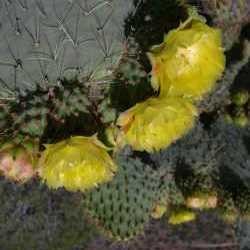Nopal de lenguita
(Nopalea auberi)

Description
Opuntia auberi is a flower plant species belonging to the family Cactaceae. It is native to Central America in Cuba and the Antilles. Opuntia auberi grows in the form of a tree and reaches a height of 3 to 8 meters and more. The branches occur at right angles from the trunk. The stem is cylindrical and has brown color with gloquidia. It is blue-green to gray-green, with large pieces up to 30 centimeters long. The flowers are pink and measure up to 9 cm long. Opuntia auberi was described by Ludwig Karl Georg Pfeiffer and published in Allgemeine Gartenzeitung in 1840. Opuntia, commonly called prickly pear or pear cactus, is a genus of flowering plants in the cactus family Cactaceae. Prickly pears are also known as tuna (fruit), sabra, nopal (paddle, plural nopales) from the Nahuatl word nōpalli for the pads, or nostle, from the Nahuatl word nōchtli for the fruit; or paddle cactus. The genus is named for the Ancient Greek city of Opus, where, according to Theophrastus, an edible plant grew and could be propagated by rooting its leaves. The most common culinary species is the Indian fig opuntia (O. ficus-indica). O. ficus-indica is a large, trunk-forming, segmented cactus that may grow to 5–7 m (16–23 ft) with a crown of over 3 m (10 ft) in diameter and a trunk diameter of 1 m (1 yd). Cladodes (large pads) are green to blue-green, bearing few spines up to 2.5 cm (1 in) or may be spineless. Prickly pears typically grow with flat, rounded cladodes (also called platyclades) containing large, smooth, fixed spines and small, hairlike prickles called glochids that readily adhere to skin or hair, then detach from the plant. The flowers are typically large, axillary, solitary, bisexual, and epiperigynous, with a perianth consisting of distinct, spirally arranged tepals and a hypanthium. The stamens are numerous and in spiral or whorled clusters, and the gynoecium has numerous inferior ovaries per carpel. Placentation is parietal, and the fruit is a berry with arillate seeds. Prickly pear species can vary greatly in habit; most are shrubs, but some, such as Opuntia galapageia of the Galápagos, are trees.
Taxonomic tree:







